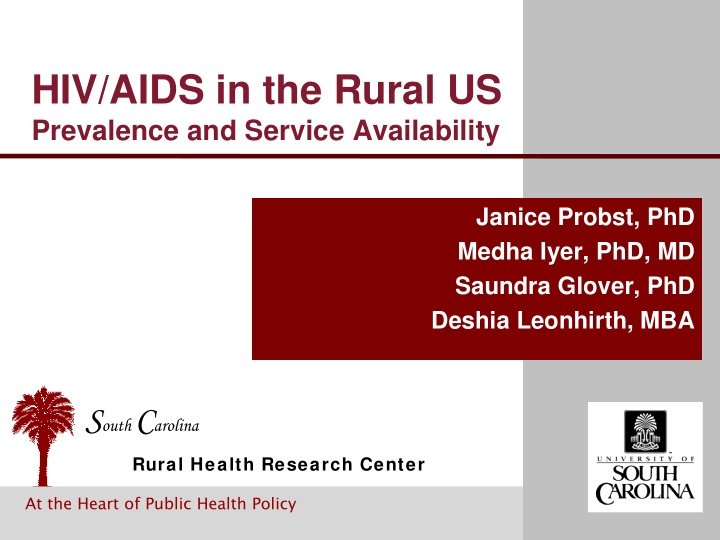



HIV/AIDS in the Rural US Prevalence and Service Availability Janice Probst, PhD Medha Iyer, PhD, MD Saundra Glover, PhD Deshia Leonhirth, MBA S outh C arolina Rural Health Research Center At the Heart of Public Health Policy
HIV/AIDS Basics Human Immunodeficiency Virus (HIV) reduces CD4 lymphocyte cells, needed to combat infection CD4 count < 200, or selected diagnoses, considered to be Acquired Immune Deficiency Syndrome (AIDS) Treatment protects CD4 cells, immune system At any level, person is contagious and should be educated re precautions S outh C arolina Rural Health Research Center
HIV/AIDS importance Estimated 1.2 million persons living with HIV/AIDS (PLWHA) Disproportionately affects minorities, women, persons living in the South Could it become a rural disease? Prevalence in rural America Service availability in rural America S outh C arolina Rural Health Research Center
Prevalence: Data sources County data retrieved from state department of health web sites, 2008 data 28 states, 2,012 counties SCRHRC Study, available at rhr.sph.sc.edu County data from 2013 RWJ County Rankings data base, 2009 Data provided by CDC’s National Center for HIV/AIDS, Viral Hepatitis, STD, and TB Prevention County-level data from AIDSVu, 2010 data, also from CDC Limitations: non-reporting and data suppression S outh C arolina Rural Health Research Center
Big picture HIV is present in rural as well as urban counties “High” is in relation to the national median rate. HIV tracks closely with poverty and with minority race/ethnicity HIV rates in rural are growing S outh C arolina Rural Health Research Center
HIV/AIDS prevalence, 28 states, 2008 Q1 <33.50 Q2 ≥33.50 < 63.81 Q3 ≥63.81 < 135.24 Q4 ≥135.24 Rates per 100,000 S outh C arolina Source: HIV/AIDS in Rural America , rhr.sph.sc.edu Rural Health Research Center
HIV prevalence, 2009, 43 states, by rurality Source: SCRHRC analysis of RWJ County Rankings S outh C arolina data, http://www.countyhealthrankings.org/rankings/data. Rural Health Research Center
HIV Prevalence, 2010, by rurality Source: S outh C arolina SCRHRC analysis of AIDSVu data Rural Health Research Center (aidsvu.org)
Tiny changes may be harbingers Kansas, Oklahoma Kansas, Oklahoma 2009 2010 S outh C arolina Rural Health Research Center
Rural/urban HIV prevalence, 28 states, 2008 States: Iowa Minnesota Michigan Statewide Prevalence of HIV/AIDS Ohio Vermont Kansas Prevalence of HIV/AIDS in Rural Counties Missouri Oregon Oklahoma Indiana Maine Washington New Hampshire Pennsylvania Texas California Colorado Arizona New York Massachusetts Illinois Virginia Maryland North Carolina Florida Louisiana S outh C arolina Mississippi South Carolina 0 100 200 300 400 500 600 Rural Health Research Center HIV/AIDS Cases per 100,000 population
Rural/urban HIV prevalence, 16 states, 2010 (Data from AidsVu.org) HIV+ per 100,000 Florida South Carolina Delaware New York Rural Louisiana Massachusetts Urban North Carolina Hawaii Maryland Alabama Connecticut Arizona Pennsylvania Source: AIDSVu. Restricted to 16 states New Hampshire with complete county data Maine S outh C arolina Vermont Rural Health Research Center 0 100 200 300 400 500 600
HIV treatment Chronic treatment with antiretroviral medications costs about $10,000 - $12,000 per year Nearly half of PLWHA receive care through the Ryan White program Current funding ~ $2.1 billion 30% of Ryan White funding specifically directed to urban areas (Part A) Ryan White providers a proxy for care availability Limitation: no information VA, other providers S outh C arolina Rural Health Research Center
Ryan White providers, 50 states, 2008 S outh C arolina Rural Health Research Center
Why worry? Distance may matter Norton KS to Wichita KS: 268 miles Guymon OK to Oklahoma City: 263 miles S outh C arolina Rural Health Research Center
Conclusions Few Ryan White providers in rural counties Research is needed to assess effects of local service availability on remaining in care, health outcomes Research is needed to assess use of other providers in rural areas CHC’s, health departments may help, but: HIV is a complex condition requiring specialized knowledge VA addresses non-specialist quality of care through telemedicine and tele-education S outh C arolina Rural Health Research Center
Recommend
More recommend